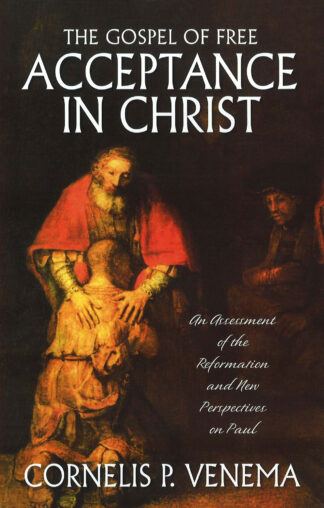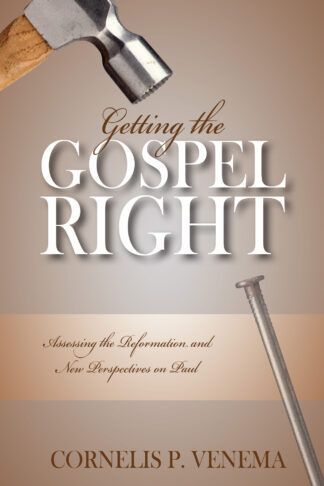The Gospel of Free Acceptance in Christ
A review by Rev William Macleod of Cornelis P. Venema’s The Gospel of Free Acceptance in Christ.1
This is a book for which I have been waiting. The subtitle describes it as ‘An Assessment of the Reformation and New Perspective on Paul’. Having heard many recent references to the New Perspective and lectures on the subject I found myself somewhat confused. What exactly is this New Perspective? Well here is a thorough treatment of it and an answer to it which shows how unbiblical this dangerous new heresy is.
The doctrine of justification is a vital one. Luther described it as the ‘article of a standing or falling church’ and Calvin as the ‘main hinge of the Christian religion’. Become unhinged here and the Christian faith will collapse.
Venema begins by giving an excellent presentation of the classic understanding of this doctrine and shows how James’ justification by faith and works fits in with Paul’s justification by faith alone. He then describes the New Perspective. This is followed by a careful treatment of several of the critical passages in Paul’s writings. While bearing in mind the findings of modern scholarship he shows that the New Perspective writers fail to do justice to the Pauline Scriptures. These new ideas on justification are appealing in an ecumenical age which wishes to downplay the Reformation and the radical difference between the Reformed position on justification and that of the Roman Catholics.
The ‘New Perspective’ began with the publication of a major work, Paul and Palestinian Judaism (1977) by E. P. Sanders, Emeritus Arts and Science Professor of Religion at Duke University, North Carolina. In this book he draws on many primary sources from the period 200BC to 200AD to argue that the common view held by the Reformers and their followers, that Palestinian Judaism in the time of Jesus and Paul was a religion of works, was wrong. Instead he argues it was a religion of grace. He shows that the Jews understood that they were chosen by grace and so had their place in the covenant. Also it was by grace their sins were forgiven. However the people of Israel were obliged to obey the law to maintain their covenant relationship and secure a place in heaven. So it is a religion of grace in some ways and of works in others but Sanders emphasised the grace aspect. Building on this ‘New Perspective’, J. D. G. Dunn and especially Bishop Tom Wright of Durham argue that Paul’s writings need to be reinterpreted and that the Reformation understanding of justification by faith alone is quite wrong. Wright argues that the ‘works of the law’ are boundary markers, and include such things as circumcision and dietary laws, which mark the Jews as the covenant people. The Jews demanded that the Gentiles be circumcised, etc. before they obtain a place in the covenant community. These ‘works of the law’ or ‘boundary markers’ as they call them are what Paul was opposing. Faith in Christ is the new boundary marker or way of entry into the covenant community. Because their religion was one of grace it is wrong, they argue, for the Reformers to equate the Jews and Pharisees with the Medieval Roman Catholics. They reject the idea of the imputation of Christ’s righteousness to us. Wright states, ‘Righteousness is not an object, a substance or a gas which can be passed across the courtroom’. He sees it simply as God’s faithfulness.
However the Medieval church did not either believe in salvation by works alone (i.e. Pelagianism – which is in reality very rare) but believed that it is by grace that we are saved along with a contribution from our own works (known as Semi-Pelagianism). Just like the Pharisees they too believed in grace but also believed that their own works were necessary to ultimate salvation. It is faith plus works that is the problem with both, and the researches of Sanders do not change that. Sanders admits that there is a place for works in the Jewish understanding of the way of maintaining their place among the covenant people. But it is this place given to works in saving ourselves that Paul will not have. While the New Perspective gives some useful insights, in reality it only confirms the similarity between the Judaisers and the Roman Catholics (both were semi-Pelagians with a grace plus works salvation).
While the New Perspective writers argue that Paul was simply concerned about the boundary markers which excluded the Gentiles, they fail to see that Paul appeals to the law as a schoolmaster to bring us to Christ (Gal.3:24). The law is not just a boundary marker but exposes human sinfulness and the inability of all men, Jews and Gentiles, to fulfil God’s demands (Rom.7:7-12). Paul, contrary to the views of Tom Wright, clearly teaches imputation, for example in the case of the adulterer David: ‘God imputeth righteousness without works’ (Rom.4:6, 22-25). The New Perspective sees justification as an ecclesiological doctrine (showing who belongs to the church) rather than soteriological (setting out the way for the individual to be saved).
The New Perspective does not explain the connection between the work of Christ and justification. The righteousness of God is seen simply as his covenant faithfulness and not also as something imputed to the sinner. Yet Paul uses the language of imputation especially in Romans 5. Further, in the clearest of words, he says that God ‘hath made him to be sin for us, who knew no sin; that we might be made the righteousness of God in him’ (2 Cor.5:21). In the New Perspective faith is simply a badge of the new family and not the instrument of justification which receives Christ and every blessing in Christ (Gal.3:13-14). Paul in Romans 8:1 states that there is now no condemnation to them who are in Christ Jesus, but the New Perspective authors argue that everything depends upon a judgment of works at the end of the day which threatens the heart of Paul’s gospel of grace.
The New Perspective, as Venema says, ‘is tantamount to “another gospel” which merits Paul’s apostolic “anathema” of Galatians 1:8-9’. Beware of this new teaching which is simply a modern rehashing of the old heresy of Semi-Pelagianism – justification by grace plus works. Let us rather hold tenaciously to the Reformation watchword: ‘faith alone, by grace alone, in Christ alone’.
Though well-written this is not the easiest book to read. However I would strongly recommend all ministers, elders and lay preachers to get a copy and familiarise themselves with the arguments.
Notes

The Gospel of Free Acceptance in Christ
An Assessment of the Reformation and the New Perspective on Paul
price From: $15.00Description
A review by Rev William Macleod of Cornelis P. Venema’s The Gospel of Free Acceptance in Christ.1 This is a book for which I have been waiting. The subtitle describes it as ‘An Assessment of the Reformation and New Perspective on Paul’. Having heard many recent references to the New Perspective and lectures on the […]
Also avaliable from the Trust is a more condensed response to the New Perspective, by the same author:

Getting the Gospel Right
Assessing the Reformation and New Perspectives on Paul
price From: $6.00Description
A review by Rev William Macleod of Cornelis P. Venema’s The Gospel of Free Acceptance in Christ.1 This is a book for which I have been waiting. The subtitle describes it as ‘An Assessment of the Reformation and New Perspective on Paul’. Having heard many recent references to the New Perspective and lectures on the […]
From the British Church Newspaper, 16 February 2007, with permission.
Latest Articles
Jeremy Walker Surveys Recent Banner Titles December 17, 2025
Not every Banner title is for every reader in every season. Books have different strengths, readers different needs and circumstances. For this reason, sometimes a digest of books can help, pointing the way to a book in season. Jeremy Walker, pastor of Maidenbower Baptist Church and Book Reviews Editor for the Banner of Truth Magazine, […]
Biblical Mission Has Biblical Churches as its Goal December 10, 2025
This is the fourth of four posts from Peter Schild (translated by Michael T. Schmid) which together constitute his booklet The Church and Missions. In Acts chapter 14, beginning with verse 21, we see the result of their work: ‘And when they had preached the gospel to that city and made many disciples, they returned […]
